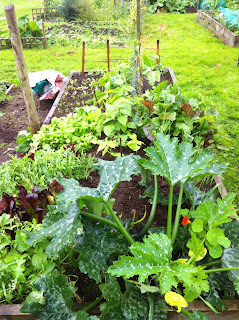The idea germinated
while listening to a friend in France talking about permaculture
principles. She recommended I read a book written by Sepp Holzer, a
farmer who has devoted his lifetime to working with nature while
farming the mountainsides in Austria.
The book:
Permaculture, a Practical Guide for
Farmers, Smallholders & Gardeners
with its hands on practical advice fascinated me from the start.
I had been looking
for new ways to enjoy gardening. Being affected by MS, my mobility
had greatly decreased in the past couple of years. My regular visits
to Minnowburn, which had always been a precious source of serenity
and joy, had slowly become a torture.
My knees could not
endure another growing season!
I decided to
sacrifice my raised bed to experiment with the idea of creating a
bed, shaped like a pyramid and based on permaculture principles.
(Building
raised beds: drawing from Holzer,
Sepp(2010)Permaculture.
p40, Permanent Publications)
With the help of Emma, Tommy and Martin (they did most of the work too be fair, and I am full of gratitude), we started by digging out and emptying the box frame of its soil. We consolidated the wooden frame of the bed with stakes at each corner and hammered a pole in the middle of one of the long sides of the box, to reinforce the side as well as to give me something firm to hold on to when moving around the bed.
Then we built the
layers as follows:

- Dead wood
- Grass sods, grass face down
- Horse manure
- Compost
- Top Soil
The height achieved allowed me straight away to start gardening from the seat of my rollator.
Towards the end of
May, I started sowing carrots, beetroots, spring onions, turnips, cos
lettuce, lambs lettuce, rocket on both sides of the pyramid (or “the
mount” as Martin likes to call it).
On the ridge, I
sowed French beans and put a courgette plant on the top edge,
interplanted with Nasturtiums.
I noticed very
quickly that everything was growing at a much faster rate than the
rest of my plot, where most vegetables seemed to be struggling to
survive the wet conditions in spring and early summer as well as the
tedious attacks from slugs and snails.
The crops have been
amazing and abundant. One of the great advantages of this raised bed
is that there is very little maintenance required. As most of the
soil is covered by vegetables, there is no weed. The slugs do not
seem to enjoy the climb up the sides of the box frame and therefore,
there is very little damage to young plants.
Other key
advantages:
- The soil is light and loose
- There is excellent drainage
- The soil is full of nutrients
This adapted
solution has changed my life at Minnowburn this year by meeting my
new needs and by giving me the best harvest to date. I truly
recommend it!
Muriel Renou













